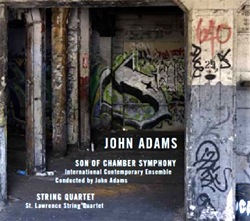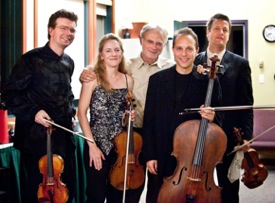
John Adams followed up his 1992 Chamber Symphony with a similarly orchestrated work 15 years later, and he opted for the playful title of Son of Chamber Symphony, instead of calling it “No. 2” or such.
Playfulness is instantly obvious when you start listening to the first movement. It’s abandoned, bouncy music, a fun piece, music in high spirits — something we all could use more of.
A sense of freedom is one of Adams’ many attractive musical qualities, and the two works on this CD are excellent examples of that, and both are Stanford Lively Arts co-commissions.
Within the 24-minute Son, Adams’ creative juices are flowing freely. The second movement opens with meandering (or searching) notes, and the march of the third movement reminds the listener of “old-Adams Minimalism,” the kind of insistent but restrained rhythmic patterns that have always characterized this composer’s work, no matter from what period. Instead of the mechanical ostinato of some of his contemporaries, Adams offers pulsing, vibrating clusters of attractive sound.
This music, suffused with pulsating energy, served as the commissioned score for Mark Morris’ Joyride, part of the San Francisco Ballet’s New Works Festival, celebrating the company’s 75th anniversary in 2008.

On this Nonesuch Records release, the music is performed by the International Contemporary Ensemble (ICE), led by the composer. Chamber Symphony Sr. and Jr. are similar in instrumentation. Says Adams:
Fifteen players — a large chamber group, or a very small orchestra — which means everybody gets to be a soloist in one way or another. It gave me an opportunity to do the kind of challenging virtuoso writing that I would never attempt with a large orchestra. The new chamber symphony also has the same buoyant quality [as the first].
The second work is the 2008 String Quartet, which the St. Lawrence String Quartet premiered the following year. That ensemble, for which Adams wrote the piece, is also heard on this Nonesuch recording. The St. Lawrence — consisting of Geoff Nuttall, Scott St. John, Lesley Robertson, and Christopher Costanza — has an unusual performance history of this work, having played it more than 50 times all over the world in just a year and a half.
Listen To The Music
Son of Chamber Symphony: I. (excerpt)String Quartet: I. (excerpt)
Purchase Recording

A portion of each purchase helps
support San Francisco Classical Voice
This is Adams’ second string quartet, though the first one called as such. The initial one was written for the Kronos Quartet in 1994, named John’s Book of Alleged Dances.
When the St. Lawrence gave the String Quartet’s West Coast premiere at Stanford University, Georgia Rowe’s review in the San Jose Mercury News called it one of Adams’ “most brilliant and inventive masterworks.”
The work, in two movements, has the same kind of rhythmic excitement and aliveness that characterizes Son of Chamber Symphony. Apparently, recent years have been happy ones for Adams.
Violinist Nuttall, of the St. Lawrence, hit the nail on the head describing the String Quartet as a “full-body experience,” with its driving intensity, interspersed with lyrical, melodic passages of the kind that increasingly characterizes Adams’ late works.
The composer and this ensemble will come together again during the San Francisco Symphony’s 2011–2012 centennial season with Absolute Jest, for string quartet and orchestra, a world premiere commission. That work will be performed in SFS’ American Mavericks festival in 2012 here, and also on a two-week national tour leading to Carnegie Hall.

![Adams_album_cover[2].jpg](/sites/default/files/styles/floated_content_270x/public/media/2011-05/Adams_album_cover%5B2%5D.jpg?itok=PsKWPj3C)